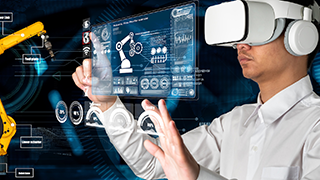Loading.....

2025-01-02
Animation has always been at the forefront of technological innovation, continually redefining how stories are told and worlds are created. Recently, technologies like artificial intelligence (AI), virtual production, and virtual reality (VR) have been making significant strides in the industry. These advancements are not only streamlining workflows but also opening up new realms of creative possibilities. Let’s explore how these trends are shaping the future of animation industry.
AI has transformed various facets of the animation industry, from content creation to production efficiency. Some key ways AI is influencing animation include: Automated Animation Processes: Algorithms can now assist in automating repetitive tasks, such as in-betweening (creating intermediate frames), which speeds up the production process. Tools like Adobe’s Sensei and DeepMotion are examples of AI-driven animation software. Procedural Animation: AI can generate complex animations based on a couple of rules. For example, AI-powered crowd simulation tools can populate a scene with lifelike characters that react dynamically to their environment. Style Transfer: AI can mimic artistic styles, allowing animators to transform 3D models or 2D animations into visually unique art styles without manual reworking, which can make artist life a little easy. Facial Animation: Machine learning algorithms are making it easier to create realistic facial animations by analyzing and replicating subtle human expressions for animators. As AI brings efficiency, it also raises questions about the balance between automation and artistic expression, pushing animators to focus more on creative aspects of storytelling.
Virtual production, popularized in projects like The Mandalorian, is becoming a game-changer in animation. This technology involves using real-time rendering engines, like Unreal Engine or Unity, to create environments and characters that can be manipulated interactively during production. Real-Time Rendering: Virtual production allows animators and directors to visualize scenes in real-time, reducing the need for lengthy rendering processes. This accelerates decision-making and fosters more collaborative workflows which is less time taking. Immersive Environments: By integrating live-action footage with virtual environments, creators can achieve a seamless blend of physical and digital elements, resulting in visually stunning scenes, which also helps in realistic visual scenes. Improved Collaboration: Virtual production enables teams to work remotely on the same digital set, facilitating global collaboration without the need for physical studio spaces.
VR is redefining how audiences experience animated content, shifting from passive viewing to active participation in production. Immersive Storytelling: VR allows viewers to step inside animated worlds, offering a 360-degree perspective and interactive elements. Films like Henry and Gloomy Eyes demonstrate the potential of VR as a storytelling medium in animation industry. Animation Creation in VR: Tools like Quill by Meta and Tilt Brush by Google enable artists to create animations directly within a virtual environment, offering a new dimension of creative freedom. Educational and Training Applications: Animated VR experiences are being used for educational purposes, such as teaching complex concepts or training professionals in simulated environments, education industry uses this for their development. While VR in animation is still in its early stages, its potential for creating deeply engaging and personalized experiences is amazing.
As AI, virtual production, and VR continue to evolve, the animation industry stands on the brink of a new era. These technologies are empowering creators to push boundaries, streamline workflows, and craft experiences that were once unimaginable. For aspiring animators and professionals alike, staying informed about these trends is crucial to thriving in this dynamic field. The future of animation is not just about telling stories—it’s about creating worlds that audiences can live in. To learn more about animation industry, join Bangalore Animation College, which is a degree college, affiliated to NAAC A graded university. Bangalore Animation College provides BSc Animation, BA Animation, MSC Animation, MA Animation and Professional Diploma in Animation and Graphic Designing courses.
Go Back
Axis Bank
Bangalore Animation College
921020032375527
UTIB0004426
Cambridge Layout

Axis Bank
Bangalore Animation College
921020032375527
UTIB0004426
Cambridge Layout

Axis Bank
Bangalore Animation College
921020032375527
UTIB0004426
Cambridge Layout

Axis Bank
Bangalore Animation College
921020032375527
UTIB0004426
Cambridge Layout